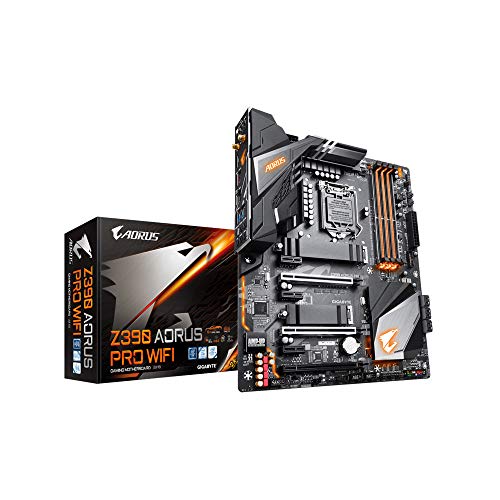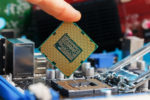Best Motherboard for i9 9900K: Complete Reviews With Comparisons

The i9 9900K is an eight-core, sixteen-thread, 9th generation Intel processor with a base frequency of 3.60 GHz and a maximum turbo frequency of 5.00 GHz.
This processor can be a monster at its max clock rate, but the i9-9900K is not a standalone component.
Like other PC components, the i9-9900K needs to work hand in hand with other PC parts to deliver the optimum performance every user deserves.
One of the essential pairings is with a motherboard. The best motherboards for i9 9900K ensures that a processor as expensive as this one does not go to waste.
We have compiled some reviews of a few top-rated motherboards that make a good and deserving match for the i9-9900K processor.
Comparison Chart
Motherboard for i9 9900K: A Review
1. MSI Z390-A PRO LGA1151 Motherboard
The MSI Z390-A PRO is the most affordable Z390 chipset MSI motherboard pairable with the i9-9900K processor.
Some consider it somewhat expensive for an entry-level motherboard, but the i9-9900K is a beast, and the cost of the MSI Z390-A PRO makes it capable of taming that beast.
Unlike most MSI Z390 motherboards, this particular LGA 1151 motherboard has a set of features that MSI did not specifically design for gamers.
It is more of a general use motherboard that you can streamline for a wide range of applications.
ALSO READ: Best Ryzen Motherboard
Product Highlights
The MSI Z390-A PRO is quite simple with its coffee-colored design and silver patterns.
It has two full-length PCIe 3.0 slots, one running at 16 lanes and another at four lanes.
In addition to its main expansion slots, the MSI Z390-A PRO has four PCIe 3.0 single-lane ports.
This motherboard has four RAM slots for up to 64 GB, six SATA ports, and one M.2 slot.
The rear panel connection includes one USB 3.1 Gen2 Type-A and one Type-C for high-speed input and output.
Other rear connectors include four USB 2.0 ports, aPS/2 port, six 3.5 mm audio jacks, a single LAN port, a D-Sub and DVI-D for video output, and a DisplayPort.
You can add two USB 3.0 and four USB 2.0 connectors to the rear panel using the internal headers.
What We Like
The main selling points of the MSI Z390-A PRO include a Realtek ALC892 HD audio codec and an Intel I219V Gigabit Ethernet controller.
What We Don’t Like
The downside to the MSI Z390-A PRO motherboard is that it only has one PCIe/SATA M.2 slot for high-speed memory.
Its other memory slots are six SATA ports that support RAID 0, 1, 5, and 10 arrays.
The four RAM slots also have a maximum total capacity of only 64 GB.
PROS
CONS
2. Asus ROG Maximus XI Hero (Wi-Fi) Z390 Gaming Motherboard
The Maximus XI Hero Z390 Motherboard takes its position as a top-tier mainstream board belonging to the ROG brand of Asus.
It is one of the most popular choices for an excellent motherboard for the i9-9900K, as both make an ideal pair to go against AMD’s X570 platform.
Product Highlights
The Maximus XI Hero Z390 has an 8-phase power design for CPU and 2-phase for memory.
It has four DIMM slots allowing 64 GB of memory to run up to 4400 MHz.
The board has six PCIe 3.0 expansion slots, three using 16 lanes and another three using one lane.
For storage, this motherboard has six SATA ports and two M.2 slots.
Input and output options include one HDMI, one DisplayPort, two Wi-Fi antenna connectors, one PS/2 port, five 3.5 mm audio jacks, one optical SPDIF port, and USBs.
Included USB 3.1 ports are Gen2 Type-A x3, Gen2 Type-C x1, and Gen1 Type-A x2. There are also four USB 2.0 ports.
With the Maximus XI Hero Z390, you can add more USB ports through the internal headers.
As with most Asus motherboards, the BIOS UEFI and compatible software are exceptional.
Overclocking and thermal control are almost always more user-friendly compared to other brands.
The Maximus XI Hero Z390 has eight fan headers for reliable cooling.
If you want to improve PC aesthetics, the Maximus XI Hero Z390 has RGB and ARGB headers, all of which are controllable using the compatible motherboard software.
What We Like
In addition to the built-in Intel I219V Ethernet connector, the Maximus XI Hero Z390 has wireless network connectivity using the Intel Wireless-AC 9560.
We also like that this motherboard has Clear CMOS and BIOS Flashback buttons on the rear panel for diagnostics and BIOS repairs.
To make diagnostics even better, the Maximus XI Hero Z390 has a POST-code display close to the DIMM slots.
What We Don’t Like
When it comes to overclocking stability, the Maximus XI Hero Z390 proves to be adequate, but its performance is not exceptional.
It shows stable results with XMP at 4000 MHz, but you have to reduce this speed to 3900 MHz to pass MemTest64.
PROS
CONS
3. MSI MPG Z390 Gaming Plus LGA1151 Motherboard
While the MSI Z390-A PRO is the cheapest MSI non-gaming themed motherboard, the MSI MPG Z390 Gaming Plus is also the most affordable game-themed MPG model.
The MPG Z390 Gaming Plus is an entry-level motherboard that can pair well with the i9-9900K.
Product Highlights
This board is the only red and black gaming-themed motherboard from the MSI MPG series, and it only has red LEDs and no RGB functionality.
Like the MSI Z390-A PRO, the MPG Z390 Gaming Plus uses the Realtek ALC892 codec for audio and the Intel I219V Gigabit Ethernet controller for networking.
This board has a single dual-link DVI-D and an HDMI port for display connectivity.
The MPG Z390 Gaming Plus also has the same expansion slots, memory slots, and USB connectivity available to the Z390-A PRO.
However, unlike the Z390-A PRO, the MPG Z390 Gaming Plus has two M.2 slots in addition to the six SATA ports.
What We Like
The MPG Z390 Gaming Plus improves the black and red theme while minimizing costs by adding red LEDs instead of controllable RGB lights.
However, the board comes with two RGB headers so that you can add your own LED strips.
Also, it holds two M.2 slots, allowing faster storage speeds.
What We Don’t Like
Like the Z390-A PRO, the MPG Z390 Gaming Plus only has a single full-bandwidth PCIe slot, which means only a single expansion can take advantage of 16 lanes.
PROS
CONS
4. Gigabyte Z390 Aorus PRO Wi-Fi LGA1151 Motherboard
The Gigabyte Z390 Aorus PRO Wi-Fi packs better aesthetics than the Asus ROG Maximus XI Hero and at a more affordable price.
Product Highlights
The Z390 Aorus PRO has three PCIe x16 slots and three PCIe x1 slots for expansion. It has two M.2 slots and six SATA ports.
The four DIMM slots on this motherboard can have a total capacity of 128 GB running at 4,266 MHz.
The rear panel has five USB 3.1, one USB 3.1 Type-C, four USB 2.0, one HDMI, one SPDIF optical output, one Ethernet port, and five 3.5 mm audio jacks.
What We Like
The Z390 Aorus PRO Wi-Fi topples the budget-conscious efforts of cheaper Asus and MSI motherboard models by providing more function and versatility.
It has plenty of fan headers, USB ports, a high-end audio codec, and it even offers wireless connectivity.
What We Don’t Like
The Gigabyte Z390 Aorus PRO Wi-Fi is a tad more expensive than other i9-9900K-compatible models on the affordable end of the Z390 platform.
Its added features, which are not available on cheaper models, require an additional cost.
PROS
CONS
5. Asus Prime Z390-P LGA1151 Motherboard
Asus Prime Z390 motherboards can unleash the full potential of 9th generation Intel processors.
They have comprehensive cooling solutions, innovative tuning options, and a robust power design.
Product Highlights
With the Prime Z390-P, Asus sports value and performance over aesthetics.
The board has a simple black and white design with white rays emanating in a triangular pattern from the middle of the board.
Compared to other models in these reviews, the heatsinks on this board are simple rectangles imprinted with the same rays.
The Prime Z390-P supports up to 64 GB of memory across four RAM slots.
PCIe slots include one x16, two x4, and three x1 lanes.
The board offers two M.2 slots and four SATA ports for storage.
What We Like
Its expansion slots offer support for two-way CrossFire multi-graphics configurations across PCIe 3.0 slots.
What We Don’t Like
The Prime Z390-P does not have a clear CMOS button for resetting the BIOS to factory settings.
PROS
CONS
Buyer’s Guide
When purchasing a motherboard for the i9-9900K, things to look for include compatibility and thermal solutions.
Other options to check are pretty much the basic stuff to look for when selecting motherboards.
These options include slots, ports, input, output, and diagnostic features.
RELATED: Best Motherboard for i7-10700k (Guide)
Compatibility With the i9-9900K
The i9-9900K requires a motherboard with an Intel Z390 chipset and an LGA1151 Version 2.0 CPU socket.
Overclocking Capacity
The K processors, including the i9-9900K, do not include any fan or heatsink upon purchase, which means you have to look for a thermal solution for the CPU.
The i9-9900K also has a thermal design power (TDP) of 95 watts at its base frequency, which means it will produce more heat if you run it at faster speeds.
To go over this problem smoothly, you will need a motherboard that has several options for cooling.
While CPU fan headers are standard in most motherboards, the number of system fan headers varies from board to board.
Ensure that your PC has enough cooling for the amount of overclocking you plan to do with the i9-9900K.
Slots and Ports
Check if a motherboard has all the PCIe, RAM, SATA, M.2, and NVMe slots you need for all the applications you plan to do on your computer.
Input and Output Options
For input and output, a motherboard should provide all the connectivity you require.
These connectors include USB ports, audio jacks, video ports, LAN, Wi-Fi, and Bluetooth.
Extra Features to Look For
If you are avid about overclocking, extra diagnostic features such as onboard switches, diagnostic LEDs, and POST-code displays are excellent features to include in your search.
Some aesthetic features may be essential for you. If so, look for RGB and ARGB headers, and consider the availability of lighting software.
Motherboard for i9 9900K FAQs
1. What Is a Good Temp for i9 9900K?
When overclocking with the i9-9900K, ideal core temperatures should stay below 80 degrees Celsius.
We do not recommend anything above 85 degrees.
2. Is It Worth Upgrading to i9 9900K?
Since its debut in the fourth quarter of 2018, the i9-9900K has held a steady price, but you can find it discounted now and then.
If you are gunning for clock speeds up to 5 GHz, it is worth upgrading to the i9-9900K, but be sure to pair it with a good motherboard.
3. Is the i9 9900K overkill?
For some motherboards, yes. Some motherboards cannot maximize the max turbo speeds available to the i9-9900K.
4. How Much RAM Do I Need for 9900K?
Unless you need a setup for video rendering, 16 GB RAM is quite enough for gaming.
5. Is i9 10900K Better Than i9-9900K?
The 10900K is an improved version of the 9900K, so yes, it should is better. However, for some applications, the improvement is negligible.
The 10900K has 100 MHz more speed for both base and max frequencies than the 9900K.
It’s a minimal increase, so wait for a better version if you are upgrading from the 9900K.
What Motherboard Should I Get for i9 9900K?
For our choice of the top motherboard for i9 9900K, we recommend the Gigabyte Z390 Aorus PRO Wi-Fi Motherboard.
It packs in the overclocking performance, memory and expansion versatility, and multiple input and output functionalities.
It pairs well with the i9-9900K, and you can play around with maxing out its capabilities.
Also, it is an exceptionally attractive motherboard compared to others in these reviews.



















